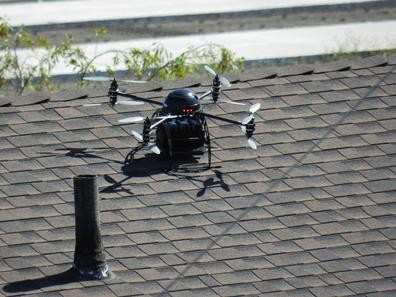Sun, May 15, 2011
Tiny Aircraft Has Extended Remote Landing Range, Reporting
Capability To Detect Occupancy In A Compound
The Phoenix50-H, a quad coaxial mini-copter system capable of
performing multiple functions such as detecting movement or
breathing of a hiding person in a compound from a sloped roof was
introduced Thursday by TiaLinx. The company develops remotely
controlled mini-unmanned aerial and ground vehicles which can be
integrated with ultra-wideband miniaturized radars. The company
says the mini-copter can be remotely controlled at extended
standoff distances of hundreds of feet from ground or an airborne
assets to keep the operators out of harm's way.

TiaLinx Image
The lightweight and agile mini-copter can be programmed to fly
to or land at multiple waypoints. It has been integrated with
TiaLinx's fine beam ultra-wideband (UWB), multi-Gigahertz radio
frequency (RF) sensor array. An onboard microphone and video camera
augment the sensor capability of Phoenix50-H. TiaLinx's advanced
real-time and lightweight UWB RF imaging system was an essential
step in the development of Phoenix50-H to operate at high
elevations for prolonged missions. The transmitted power of the UWB
signal is less than a typical cellular phone.
Through a software-controlled interface which is integrated into
a laptop or joystick controller unit, Phoenix50-H can be remotely
guided from extended distances to perform mission-critical tasks.
Innovations in mechanical design of the system allow for smooth
landing and take-off from sloped roofs. This advanced feature
allows for monitoring a premise under surveillance for enhanced
situational awareness or rescue operations of hard-to-access
buildings.
The ultra-lightweight RF Scanner is mounted on a lightweight
mini-copter and transmits wideband signals that are highly
directional and can penetrate roofs at an extended range. In the
receiver, a signal detector circuit is employed to capture the
reflections from targets. Amplitude and delay information are then
processed in an integrated signal processor.
System evaluations indicate that a remotely controlled system at
an extended range from an operator point of view is essential for
safety and completion of a critical mission. The introduction of
the Phoenix50-H's is intended to provide advanced miniaturized life
detection sensors in compounds and to keep the operators at least a
few hundred feet away.
More News
Performance-Based Navigation (PBN) [ICAO] Area navigation based on performance requirements for aircraft operating along an ATS route, on an instrument approach procedure or in a d>[...]
The Airplane Came To Rest Underneath A Set Of Damaged Power Distribution Lines On The Floor Of A Coulee On June 19, 2025, at 1412 mountain daylight time, a Cessna 172K airplane, N7>[...]
Aero Linx: FAA Managers Association (FAAMA) Recognized by the FAA, FAAMA is a professional association dedicated to the promotion of excellence in public service. The Association i>[...]
From 2023 (YouTube Edition): Jet Central Micro-Turbine Engines Impress Founded in the late-1990s, Mexico City-based Jet Central produces a unique and fascinating line of micro-turb>[...]
Also: ANOTHER Illegal Drone, KidVenture Educational Activities, Record Launches, TSA v Shoes The Senate confirmed Bryan Bedford to become the next Administrator of the FAA, in a ne>[...]
 ANN's Daily Aero-Term (07.10.25): Performance-Based Navigation (PBN) [ICAO]
ANN's Daily Aero-Term (07.10.25): Performance-Based Navigation (PBN) [ICAO] NTSB Prelim: Cessna 172
NTSB Prelim: Cessna 172 ANN's Daily Aero-Linx (07.10.25)
ANN's Daily Aero-Linx (07.10.25) Classic Aero-TV: The Big Business of Diminutive Powerplants
Classic Aero-TV: The Big Business of Diminutive Powerplants Airborne 07.11.25: New FAA Bos, New NASA Boss (Kinda), WB57s Over TX
Airborne 07.11.25: New FAA Bos, New NASA Boss (Kinda), WB57s Over TX



